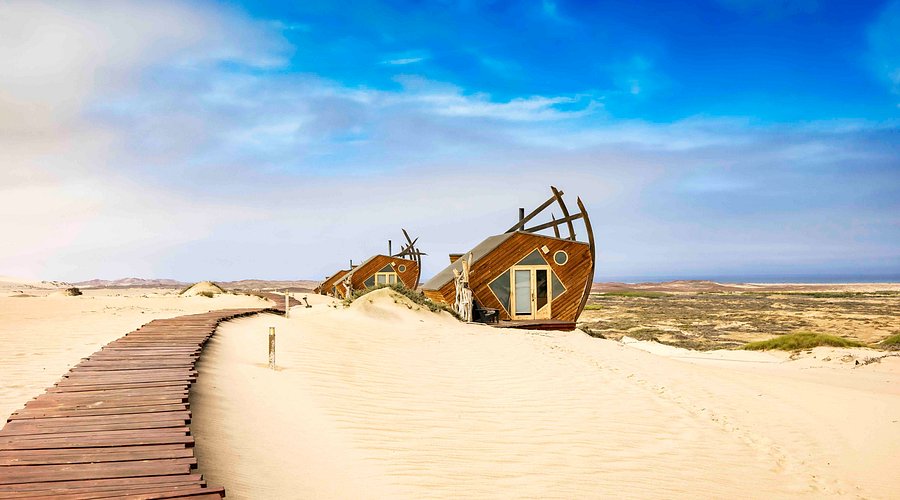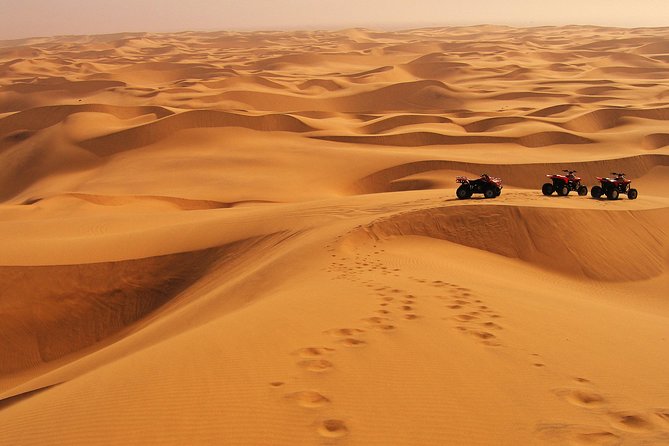Chasing Ghosts on Namibia's Skeleton Coast

The Skeleton Coast. The name alone conjures images of desolate beauty and forgotten shipwrecks. I'd seen the photos, the iconic shots of rusted hulls against towering dunes, but nothing prepared me for the sheer scale and surreal atmosphere of this Namibian wonderland. For a landscape photographer like myself, it was a dream come true, albeit a slightly intimidating one. If you are planning Skeleton Coast travel, be sure to do your research as this truly unique place requires ample planning and respect for the environment.
Arrival and First Impressions: The Suiderkus Shipwreck
Landing at Mowe Bay, the only airstrip for hundreds of kilometers, felt like arriving on another planet. The wind howled relentlessly, carrying sand that stung my face, and the air was thick with a salty mist rolling in from the Atlantic. Our guide, Immanuel from Skeleton Coast Safaris, greeted us with a weathered smile and a Land Cruiser equipped for anything. First stop, the 'Suiderkus' shipwreck, a truly ghostly sight looming out of the fog. It perfectly encapsulates the harsh beauty that makes the Skeleton Coast National Park so captivating. The contrast of the rusted metal against the constantly shifting sand dunes creates a truly unique photographic opportunity.
The Suiderkus shipwreck bathed in golden hour light, showcasing the stark beauty of the Skeleton Coast's landscape. The rusted hull contrasts sharply with the towering dunes in the background, highlighting the region's desolate yet captivating charm. This image captures the ghostly atmosphere that draws photographers and adventurers alike to this remote corner of Namibia.
Quad Biking Adventure Through a Shifting Landscape
The next day, Immanuel took us quad biking through the sand dunes. This wasn't some touristy joyride. It was an adrenaline-pumping adventure through a seemingly endless expanse of sand. The landscape was constantly shifting, sculpted by the wind into towering peaks and deep valleys. Reaching the top of one dune, overlooking the Atlantic, was an unforgettable experience. For thrill-seekers, quad biking Skeleton Coast Namibia is an absolute must-do! Ensure you choose a reputable operator, and always prioritize safety.

A lone quad bike conquers a towering sand dune on the Skeleton Coast. The rider's silhouette against the bright sky evokes a sense of adventure and freedom, illustrating the thrill of exploring this vast, ever-changing landscape.
Local Cuisine and Culture: Braaivleis Under the Namibian Sky
After a day of adventure, nothing beats a traditional Namibian braaivleis. Back at our lodge – the simple, yet comfortable, Skeleton Coast Camp – Immanuel grilled Oryx steaks over an open fire. The meat was rich and flavorful, and the conversation flowed as freely as the Windhoek Lager. Immanuel shared stories of the local Himba people, their traditions, and their resilience in this harsh environment. Exploring Namibian cuisine and culture adds a rich layer to your trip, helping you truly connect with the land.
Stargazing in the Namib Desert: A Celestial Spectacle
One of the highlights of the trip was stargazing. Away from any light pollution, the Namib Desert sky exploded with stars. The Milky Way stretched across the horizon like a river of light. I spent hours photographing the constellations, feeling incredibly small and insignificant under the vastness of the universe. For astrophotography enthusiasts, the Skeleton Coast offers some of the darkest skies on Earth. Consider booking Namibia stargazing tours for optimal viewing and guidance.

The Milky Way blazes across the night sky above the Namib Desert, with a quiver tree silhouetted in the foreground. This stunning image captures the raw beauty and otherworldly atmosphere of the Skeleton Coast at night, showcasing its potential for astrophotography.
Photographic Tips and Gear for the Skeleton Coast
For any photographer planning a trip to the Skeleton Coast, my advice is to be prepared for harsh conditions. Bring plenty of water, sunscreen, and lens wipes. A sturdy tripod is essential for landscape photography, and a zoom lens is useful for capturing wildlife from a distance. Don't forget a dustproof camera bag to protect your equipment from the sand. Here's a quick gear checklist for Skeleton Coast Namibia photography:
- Camera: A full-frame camera like my Sony a7IV is ideal, but any DSLR or mirrorless will work.
- Lenses: A wide-angle lens (14-24mm) for landscapes and the Milky Way, and a zoom lens (70-200mm or longer) for wildlife.
- Tripod: A sturdy tripod is essential for sharp landscape photos, especially at sunrise, sunset, and night.
- Filters: A polarizing filter can reduce glare and enhance colors, while a neutral density filter can help you achieve long exposures.
- Camera Bag: A dustproof and waterproof bag is essential to protect your gear from the harsh environment.
- Cleaning Supplies: Lens wipes, a microfiber cloth, and a blower brush are all essential for keeping your lenses clean.
- Extra Batteries: Bring plenty of extra batteries, as they tend to drain quickly in the desert heat and cold.
- Rain Gear: Even though it's a desert, it's always a good idea to be prepared for rain.
The Lasting Impression: A Hauntingly Beautiful Landscape
The Skeleton Coast is more than just a beautiful landscape; it's an experience. It's a place that challenges you, inspires you, and leaves you with a profound sense of awe. It’s a reminder of the power and beauty of nature, and the importance of preserving these wild places for future generations. I can't wait to return and chase more ghosts along this incredible coastline. Always respect Sustainable Tourism Skeleton Coast practices.
Planning Your Trip to the Skeleton Coast
If you're looking for an adventure that's off the beaten path, I highly recommend a trip to the Skeleton Coast. Contact Skeleton Coast Safaris (No URL Provided) for an unforgettable experience. Just be prepared to be humbled by the sheer scale and beauty of this unique corner of the world. And don’t forget your camera! Remember to check for Skeleton Coast permits and regulations before planning your adventure.
Frequently Asked Questions About The Skeleton Coast:
What is the Skeleton Coast known for?
The Skeleton Coast is renowned for its dramatic and desolate landscapes, characterized by towering sand dunes, rugged coastline, and numerous shipwrecks. It's a popular destination for adventure travelers and photographers seeking unique and challenging experiences.
Where is the Skeleton Coast located?
The Skeleton Coast stretches along the northern part of the Atlantic coast of Namibia, from the Kunene River in the north to the Swakop River in the south.
Why is it called the Skeleton Coast?
The name "Skeleton Coast" is attributed to the numerous shipwrecks that have occurred along its treacherous coastline due to dense fogs, unpredictable currents, and strong winds. The skeletal remains of ships and whales scattered along the shore contributed to the name.
Is the Skeleton Coast safe for travel?
Traveling to the Skeleton Coast can be safe with proper planning and a reputable tour operator. However, it's essential to be aware of the harsh environmental conditions, including extreme temperatures, strong winds, and limited access to resources. Always follow the guidance of your tour operator and take necessary precautions.
What are the dangers of the Skeleton Coast?
- Extreme weather: The Skeleton Coast can experience extreme temperatures, strong winds, and dense fogs.
- Remoteness: The area is very remote and sparsely populated, with limited access to resources.
- Wildlife: While wildlife encounters can be a highlight, it's important to be aware of potentially dangerous animals such as lions, elephants, and snakes.
- Strong Currents: Swimming is not recommended in the ocean due to the presence of dangerous currents.